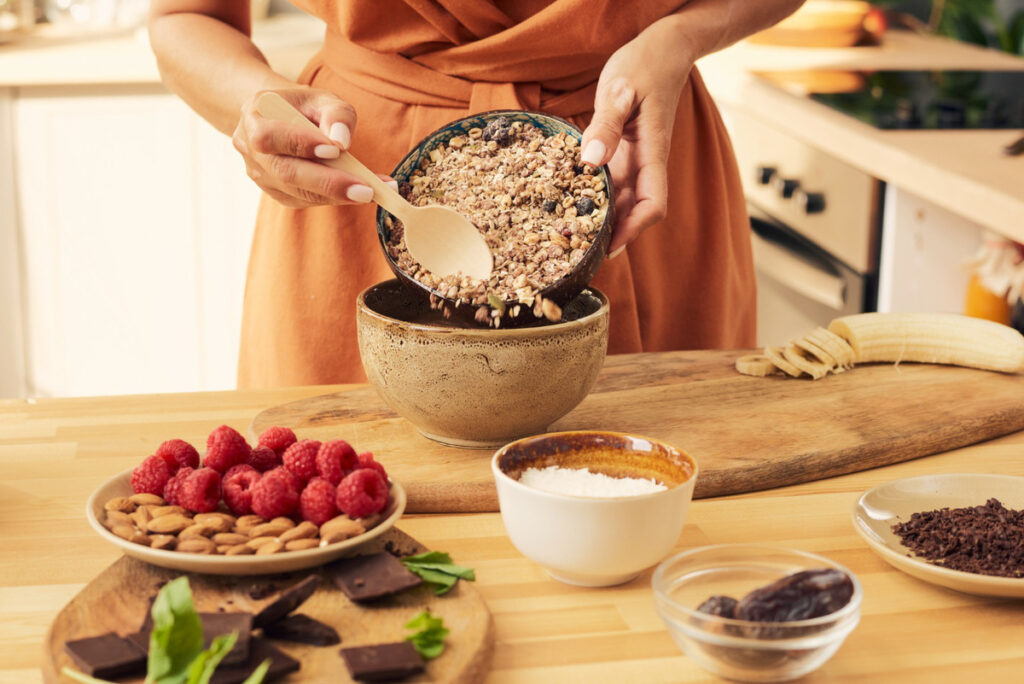Healthy cereal for weight loss can be a smart part of your morning routine—if you know what to look for.
With so many brands promising fitness and nutrition, it’s easy to get misled by flashy labels and hidden sugars.
Understanding which cereals support your weight goals and how to incorporate them into your diet can help you start the day right and stay on track.
What Makes a Cereal Healthy for Weight Loss?
Not all cereals are created equal.
To qualify as a weight-loss-friendly option, a cereal should be low in added sugars, high in fiber, and contain a moderate amount of protein.
Fiber helps you feel full longer, reducing the urge to snack between meals.
Protein adds satiety and supports muscle maintenance during weight loss.
Cereals made from whole grains rather than refined ones offer more nutrients and better glycemic control.
Look for cereals that deliver 3 to 5 grams of fiber and at least 5 grams of protein per serving with fewer than 8 grams of sugar.
For more detailed guidance on selecting nutritious breakfast cereals, refer to this Harvard Health article.
Ingredients to Look For
A healthy cereal for weight loss should start with whole grains like oats, quinoa, or sprouted wheat, which are slow-digesting and nutrient-dense.
For example, cereals like Ezekiel 4:9 contain sprouted grains that not only improve digestion but also enhance nutrient absorption.
Look for cereals that include added fiber sources such as bran, flaxseed, or psyllium husk—like Fiber One Original, which delivers an impressive 14 grams of fiber per serving.
High-protein cereals, like Kashi GoLean, blend soy protein and legumes to boost satiety and help maintain lean muscle mass.
A small amount of natural sweetness from dried fruit, like in Uncle Sam cereal, can enhance flavor without relying on added sugars.
Overall, the best cereals will feature minimal processing, recognizable ingredients, and a nutrition label showing at least 3 grams of fiber and 5 grams of protein per serving with less than 8 grams of sugar.
A healthy cereal for weight loss contains more than just whole grains.
Oats, quinoa, and sprouted grains are excellent bases because they are slow-digesting and rich in nutrients.
You’ll also want cereals that incorporate fiber from bran, flaxseed, or psyllium husk, which improve digestion and satiety.
Protein-boosted cereals that include soy or pea protein are more satisfying and help preserve muscle.
A touch of sweetness from dried fruit or a drizzle of honey is fine—just ensure sugar isn’t among the first ingredients.
Minimal processing is another sign of quality.
Cereals with visible grains and natural textures typically retain more nutrients and have fewer additives.
Ingredients to Avoid
Some cereals marketed as “fit” or “light” are loaded with ingredients that sabotage your goals.
Refined grains, like white rice or puffed corn, digest quickly and spike blood sugar, leading to crashes that trigger hunger and overeating.
Added sugars—including those disguised as cane syrup or juice concentrate—can cause insulin surges, promote fat storage, and undermine appetite regulation.
Artificial sweeteners, while low in calories, may disrupt gut microbiota and lead to increased cravings or altered glucose metabolism.
Synthetic flavors and dyes provide no nutritional value and may provoke inflammation in sensitive individuals.
Low-fiber cereals lack the bulk to slow digestion, leaving you feeling hungry soon after eating.
Check labels closely and avoid cereals where sugar appears in the top three ingredients or where the fiber content is less than 2 grams per serving.
Some cereals marketed as “fit” or “light” are loaded with ingredients that sabotage your goals.
Refined grains, like white rice or puffed corn, digest quickly and spike blood sugar.
Added sugars—including those disguised as cane syrup or juice concentrate—can contribute to cravings and fat storage.
Artificial sweeteners, while low in calories, may affect insulin sensitivity and increase hunger in some individuals.
Synthetic flavors and dyes are unnecessary and may irritate sensitive systems.
Low-fiber cereals offer little satiety and can lead to overeating.
Check labels closely and avoid cereals where sugar appears in the top three ingredients.
Top Healthy Cereals for Weight Loss (U.S. Market)
Below is a comparative overview of popular cereals that support weight loss, highlighting key nutritional and practical considerations:
| Cereal | Fiber (g) | Protein (g) | Sugar (g) | Flavor & Texture | Availability | Price Range |
|---|---|---|---|---|---|---|
| Fiber One Original | 14 | 2 | 0 | Mild, crunchy, best with fruit | Widely available | $3–$5 |
| Kashi GoLean Original | 13 | 12 | 8 | Crunchy, nutty, filling | Grocery & online | $4–$6 |
| Ezekiel 4:9 Sprouted Grain | 6 | 8 | 0 | Dense, nutty, needs soaking | Health stores | $5–$7 |
| Uncle Sam Wheat Flakes & Flax | 10 | 7 | 1 | Flaky, earthy flavor | Some supermarkets | $4–$5 |
| Cheerios (Original) | 3 | 3 | 1 | Light, slightly sweet | Very accessible | $3–$4 |
These cereals vary in flavor, texture, and availability.
Try different types to see which best matches your preferences and dietary needs while staying within your budget.
Here are five cereals that meet the criteria for weight loss support, along with key points about each:
- Fiber One Original: Extremely high in fiber (14g per serving) and contains zero sugar, ideal for curbing hunger with minimal calories.
- Kashi GoLean Original: A well-balanced option with 12g of protein and 13g of fiber per serving; excellent for active individuals.
- Ezekiel 4:9 Sprouted Whole Grain Cereal: Made from sprouted grains, it’s high in nutrients and naturally sugar-free.
- Uncle Sam Toasted Whole Wheat Flakes & Flaxseed: Provides omega-3s, 10g of fiber, and a simple ingredient list.
- Cheerios (Original): Widely available, low in sugar, and made from whole grain oats, making it a budget-friendly staple.
These options are available in most grocery stores or online.
Taste, affordability, and availability may vary, so try a few and see which fits best into your routine.
How to Eat Cereal to Maximize Weight Loss
A balanced breakfast using cereal can set a positive tone for your entire day.
Let’s look at a practical example:
Smart Breakfast Example:
- ¾ cup Kashi GoLean (measured accurately).
- ½ cup unsweetened almond milk.
- ¼ cup plain Greek yogurt stirred in for added protein.
- 1 tablespoon ground flaxseed.
- A small handful of fresh blueberries.
This bowl delivers fiber, protein, and antioxidants without excess sugar or calories.
It’s filling, promotes steady energy, and supports muscle maintenance.
To get the most from cereal meals, always measure portions, avoid sugary milk alternatives, and combine it with protein and healthy fats.
These combinations improve fullness, slow digestion, and enhance nutrient absorption.
Here’s how a strategic approach to cereal can help you reach your weight goals:
Example breakfast:
- 1 serving of Kashi GoLean (measured).
- ½ cup unsweetened soy milk.
- ½ sliced banana.
- 1 tablespoon chia seeds.
This meal provides fiber, protein, and healthy carbs without excess sugar.
General tips include using a measuring cup for accuracy, avoiding sweetened milks, and adding nutrient-dense toppings like berries, nuts, or Greek yogurt.
These strategies help improve satiety and nutrient absorption.
When to Eat Cereal for Best Results
Timing your cereal intake can influence how your body manages energy, glucose, and appetite throughout the day.
- Morning: Eating cereal for breakfast, especially one rich in fiber and protein, helps slow digestion and moderates the release of glucose into the bloodstream. This stabilizes energy levels and may reduce cravings later in the day by preventing spikes and crashes in blood sugar.
- Post-workout: After exercise, your muscles are primed to absorb nutrients. A cereal with complex carbohydrates and some protein can aid recovery and replenish glycogen stores without causing excessive fat storage.
- Evening: While eating cereal at night isn’t inherently harmful, choosing a high-carb, low-fiber option may lead to blood sugar spikes that disrupt sleep or increase fat storage. Opt for a small portion paired with protein—like Greek yogurt—to minimize impact on insulin and support satiety.
Research suggests that eating more calories earlier in the day aligns better with circadian rhythms, potentially improving insulin sensitivity and metabolic outcomes. By adjusting cereal timing to match your energy needs and biological patterns, you can enhance its weight loss benefits.
Timing your cereal intake wisely can support weight management and metabolic health.
- Morning: Starting the day with a fiber- and protein-rich cereal helps stabilize blood sugar and prevent mid-morning hunger.
- Post-workout: A bowl of cereal with a protein source helps replenish energy and muscle glycogen efficiently.
- Evening: A small bowl of cereal with Greek yogurt and berries can serve as a light, satisfying dinner—but avoid cereals high in sugar before bed, as they may disrupt insulin and melatonin cycles.
Understanding your body’s energy needs throughout the day can help you time meals more effectively.
Natural Support for Appetite Control: OrexiBurn
Even with smart dietary choices, managing hunger can be a challenge during weight loss.
OrexiBurn is a natural supplement designed to help regulate appetite, support metabolism, and promote energy balance.
Its formulation includes ingredients like L-arginine, turmeric root, Ecklonia cava, and glucoraphanin—all selected to aid in fat metabolism and reduce cravings.
By supporting orexin production, a neuropeptide tied to hunger and alertness, OrexiBurn can help you stay focused and energized without relying on stimulants.
It’s non-GMO, free from artificial ingredients, and manufactured in FDA-registered facilities in the U.S.
Make Smarter Cereal Choices for Weight Loss
Healthy cereal for weight loss can be a valuable part of your daily diet when chosen wisely.
By focusing on whole grains, high fiber, and low sugar content, you can enjoy a satisfying breakfast or snack that aligns with your goals.
To further support appetite control and metabolic health, consider adding OrexiBurn to your routine.
Learn more at the official OrexiBurn website.









